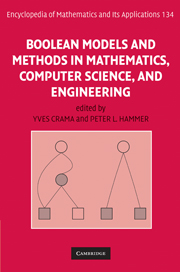Book contents
- Frontmatter
- Contents
- Preface
- Introduction
- Acknowledgments
- Contributors
- Acronyms and Abbreviations
- Boolean Models and Methods in Mathematics, Computer Science, and Engineering
- Part I Algebraic Structures
- Part II Logic
- Part III Learning Theory and Cryptography
- Part IV Graph Representations and Efficient Computation Models
- Part IV Applications in Engineering
Preface
Published online by Cambridge University Press: 05 June 2013
- Frontmatter
- Contents
- Preface
- Introduction
- Acknowledgments
- Contributors
- Acronyms and Abbreviations
- Boolean Models and Methods in Mathematics, Computer Science, and Engineering
- Part I Algebraic Structures
- Part II Logic
- Part III Learning Theory and Cryptography
- Part IV Graph Representations and Efficient Computation Models
- Part IV Applications in Engineering
Summary
Boolean models and methods play a fundamental role in the analysis of a broad diversity of situations encountered in various branches of science.
The objective of this collection of papers is to highlight the role of Boolean theory in a number of such areas, ranging from algebra and propositional logic to learning theory, cryptography, computational complexity, electrical engineering, and reliability theory.
The chapters are written by some of the most prominent experts in their fields and are intended for advanced undergraduate or graduate students, as well as for researchers or engineers. Each chapter provides an introduction to the main questions investigated in a particular field of science, as well as an in-depth discussion of selected issues and a survey of numerous important or representative results. As such, the collection can be used in a variety of ways: some readers may simply skim some of the chapters in order to get the flavor of unfamiliar areas, whereas others may rely on them as authoritative references or as extensive surveys of fundamental results.
Beyond the diversity of the questions raised and investigated in different chapters, a remarkable feature of the collection is the presence of an “Ariane's thread” created by the common language, concepts, models, and tools of Boolean theory. Many readers will certainly be surprised to discover countless links between seemingly remote topics discussed in various chapters of the book. It is hoped that they will be able to draw on such connections to further their understanding of their own scientific disciplines and to explore new avenues for research.
- Type
- Chapter
- Information
- Publisher: Cambridge University PressPrint publication year: 2010

